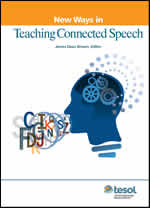TC Quick Tip: 4 Websites for Tech-Savvy Teachers
by Tara Arntsen
 Audience: All levels
Audience: All levels
Teachers should develop their technological skills regardless of the subject they teach. By using online resources, teachers can increase the amount of time they spend teaching students, because language learning can take place outside the classroom as well as in it. This is an especially important topic for ESL teachers who want to maximize the amount of time learners spend speaking English in class and minimize the amount of time spent lecturing.
Allthink
This site can be used to create engaging mini lessons. Integrating a variety of media is simple and, unlike a PowerPoint, the material exists online and is accessible to anyone with the link. The introduction video on the site explains quite simply how to create a good Allthink lesson and you can view some of the available lessons to get even more ideas. If there is a lesson already made that will suit your purposes, you can just use it as is. This site can be used to deliver instructional content outside of class. Having students view short lectures at home frees up class time for more engaging learning activities.
Kidblog
Kidblog is perfect if you want to start a blog for your classes without having to worry about advertisements and privacy issues or if you want to give written assignments and encourage peer editing. Kidblog is completely free but you have to register to start creating classes. Since you can add up to 200 students to one blog, you might decide to make just one and let all your students communicate with one another, or you could simply create a new blog for each class. All the blogs you create will be easily accessible from the control panel on your account and you can customize student account settings, too. Kidblog makes writing assignments fun—and you will never have to worry about illegible handwriting again.
Glogster
Glogster is a platform to create online multimedia posters. It offers many different account options, but if your school is not willing to pay for multiple accounts, there are free education accounts, too, which give you access to everything you need to make your own glogs. Creating glogs is very intuitive: The visuals are easy to customize to appeal to students of all ages, and you can even embed your own videos, images, and sounds. The site has a tutorial that you can watch and plenty of great sample glogs that you could use as is or as inspiration for your own creations. Glogs can be used to structure homework assignments or even for in-class activities if there is a computer lab available.
VoiceThread
A VoiceThread is a “collaborative, multimedia slide show that holds images, documents, and videos” and on which users can leave comments in writing or orally. To create a VoiceThread, upload a series of images or videos. Students can listen to comments peers have left and respond to them. The site offers free basic accounts for educators, but you and your students will all need to create accounts. Once students are familiar with the site, you could encourage students to create their own VoiceThreads to tell stories about their lives, introduce themselves, or give short presentations about topics they are interested in.
With these four sites teachers can create engaging materials that students can access outside the classroom to learn English and even, with VoiceThread, practice speaking English.
This material has been adapted, with permission, from articles written by the author for busyteacher.org.
____________________
Tara Arntsen is pursuing a master's degree in TESOL at the University of Southern California. She teaches EFL at Guangdong Peizheng College in China and has taught in Japan and Cambodia.
|
Like this article? Author Tara Arntsen will be writing a regular blog for TESOL about incorporating technology into your English language teaching.
Read her intro blog and check back regularly for more posts. |
TESOL Blogs
Interested in writing a blog for TESOL?
Contact
Craig Triplett or
Tomiko Breland with your idea or for details.
Check out the latest TESOL Blogs:
|
A Whole New World, by Tara Arntsen
 As a new blogger for TESOL, I want to take this opportunity to introduce myself to this wonderful community. My name is Tara Arntsen. I am currently pursuing a Master of Arts in TESOL online with the University of Southern California while teaching English as a foreign language to freshman at Guangdong Peizheng College in Guangzhou, China. I am from the United States but have spent more than 15 years living abroad including time teaching in Japan, Cambodia, and now China. Additionally, I have taught English online both as a freelancer and for various language companies. As a new blogger for TESOL, I want to take this opportunity to introduce myself to this wonderful community. My name is Tara Arntsen. I am currently pursuing a Master of Arts in TESOL online with the University of Southern California while teaching English as a foreign language to freshman at Guangdong Peizheng College in Guangzhou, China. I am from the United States but have spent more than 15 years living abroad including time teaching in Japan, Cambodia, and now China. Additionally, I have taught English online both as a freelancer and for various language companies.
With the importance of technology in our daily lives growing each year, I have become quite interested in technology and its role in education. I believe that teachers around the world, regardless of content area, should devote some time to this topic and develop their own skills as well as the skills of their students. Read More. |
|
Global Resources in ESP: Focus on Self-Directed Learning, by Kevin
 Hello, ESPers worldwide! Hello, ESPers worldwide!
One of my favorite things to tell my students is that they should study English 24/7 (24 hours a day, seven days a week). Of course, my students understand that I am exaggerating to a certain extent. However, I do want my students to make efforts outside of the classroom to learn English. Read More. |
|
The TESOL Symposium Facilitating Learning Through Student Empowerment: An Overview, by Maria Antonia Irizarry
 Editor’s Note: The symposium papers discussed in this blog posting are available in the TESOL Resource Center. Just click on “Find a Resource” and then in the top dropdown menu, choose “White Papers & Live Events.” Editor’s Note: The symposium papers discussed in this blog posting are available in the TESOL Resource Center. Just click on “Find a Resource” and then in the top dropdown menu, choose “White Papers & Live Events.”
The TESOL Symposium “Facilitating Learning Through Student Empowerment” was held in San Juan, Puerto Rico, on 15 November 2012 in partnership with the 36th PRTESOL Convention and the 11th Central American and Caribbean Basin Regional Conference. Read More. |
TESOL Bookstore
BRAND NEW RELEASE FROM TESOL PUBLICATIONS
 New Ways of Teaching Connected Speech
New Ways of Teaching Connected Speech
James Dean Brown, Editor
Connected speech is based on a set of rules used to modify pronunciations so that words connect and flow more smoothly in natural speech (hafta versus have to). Native speakers of English tend to feel that connected speech is friendlier, more natural, more sympathetic, and more personal. Is there any reason why learners of English would prefer to be viewed as unfriendly, unnatural, unsympathetic, and impersonal? The great news is that such rules can (and should) be explained and taught. This book makes available fun and interesting lessons, presented in a systematic way that is directly useful in the ESL/EFL classroom.
Endorsed by Nina Weinstein
Author of Whaddaya Say (Pearson)
Dr. Brown’s collection of articles includes sentence blending rules, assimilation, reduced forms, and other rules that comprise the natural pronunciation changes of real spoken English. These articles and classroom materials will give teachers a framework to prepare their learners to begin to understand real English speakers.
List $49.95; Member $38.50
Order from the TESOL Bookstore
Toll Free: 888-981-0041
E-mail: tesol@brightkey.net
Order #769
ISBN 9781931185769